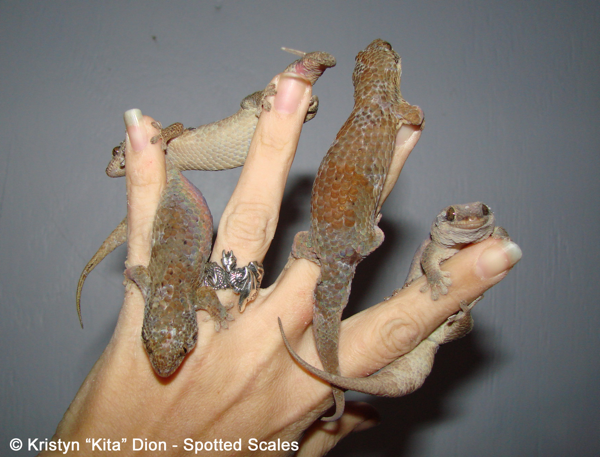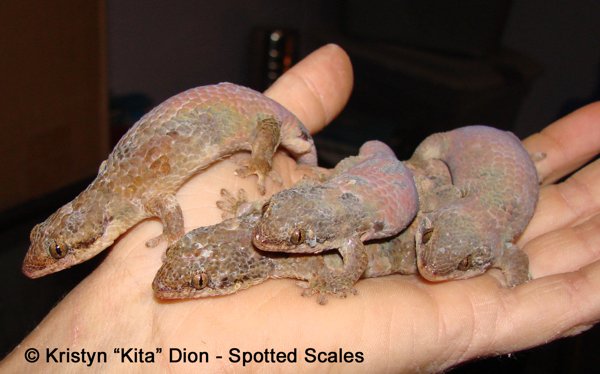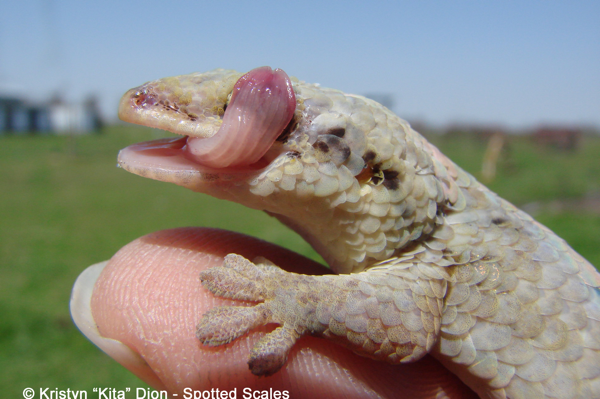I first heard of the genus Geckolepis a few years ago from online photos and was immediately drawn to their cartoon-like features with short, thick legs and their typical gecko “smiling” faces. Unfortunately, extensive searches on Google proved that there was very little information available on them let alone purchase availability and I had no better luck in the months to years in between looking them up.
This difficulty made me pass when I found a single male available a few months ago, but when someone had multiple G. maculata in January, I decided to take the chance, especially when I found out a friend had already ordered some for his local store.
First Impressions
What little I had read warned me that they were super fast, flighty, and easily shed their large scales when touched. Placed in a tank together, I took out each gecko to look them over and begin assessing their behaviors and characteristics. Three had fairly fresh wounds from fighting in a tank with few available hides and they certainly moved in short, quick bursts as I went to scoop them up.
But there was no denying the clear personalities among these tiny animals.
While the less dominant ones where clearly more wary of their surroundings due to having been picked on by at least one other, all four were openly curious and very inquisitive about their surroundings. Every few steps they would lick me, learning smells, tilting their heads every which way observing everything. None made any mad dashes to escape so there was never any reason for me to do more than cup my hand around them to lift or move them so I didn’t have any scales dropped.
Going in I had intended on only a single pair to begin and learn with, but there was no leaving without all four after meeting them. I did learn very quickly that they will display territorial behavior even while being transported instead of riding out the movement looking for somewhere to hide as I have seen in other species.
“Getting to Know You”
Since they proved tricky to sex without being obvious or knowing what to look for, I decided to set them up together in a larger tank than I had originally planned being a custom 15x23x20 and filled two thirds with branches and cork for a maze of hides. I took photo documentation of each so that I could identify them later as well as weighed them. I gave them a container of dirt in case anyone was already gravid and put it in the front with a piece of cork lying over it so I could check it without disturbing the tank. They also got bowls for water and Crested Gecko Diet since I had it on hand, which even newly arrived they were immediately coming out to lick at, as well as dubia and crickets.
With the lack of information on their care, I decided to try the methods used for Day Geckos since they are also from Madagascar. I put their tank on a lower shelf in my gecko building where it didn’t get quite as warm, but the building has ambient temperatures ranging roughly 73-85F throughout the full day. I didn’t mist at first and never saw any shedding problems though living near the coast, I have naturally high humidity anyway, but I am now heavily misting the entire tank every few days.
Making Adjustments
Since they were all choosing hides on varies places next to the glass, I was able to observe everyone’s condition easily so I left them alone for a month. After that, I took new identification photos and checked their weights. All four were fully healed from their wounds showing rapid regeneration of their scales. Since I had to remove everything in the tank to take them out, I was able to see that they ate few, if any, of the dubia I had offered, but only one cricket had managed to evade them. I have since found that prefer the Gecko Diet over insects since the bowl is cleaned quickly while crickets continue to roam.
Other Geckolepis keepers turned up on Facebook after I posted photos, and I was provided with comparison photos showing me what to look for to sex them. I have confirmed 1.2 with a small one left in question and if they turn out to be 2.2 than I will split the pairs so I can keep records of who the parents are. Recently I did find that one of them had laid an egg out of the lay box, but it was clearly infertile and very likely a virgin egg so I have also added a bowl of calcium that has since obviously been licked at. Having only had them for two months, they have proven very hardy and easy to care for. Their personalities make them a joy to interact with, though I do handle them at a bare minimum to be safe.






They remind me of Frog eyed geckoes,(Teratoscincus scincus), do they drop their tails easily?
cool i see that they are aboreal
Very nice. We are starting to see a bit more imports from Madagascar. I hope more folks will work with them to establish a captive bred population as availability is sketchy at best.
are you selling tokays
I have noticed that at least one has previously regenerated it’s tail, but I have not heard anything on that and I have not handled them with any restraint to possibly cause it so I cannot say how easily they drop them.
I do sell Tokays though I am currently sold out. I have eggs incubating, but my waiting lists build quickly. There is information about that with my contact on the availability page of my website.
I have been trying to find a way to get on your waiting list on your website. Can’t find an email address. [email protected]
Mark, yes, Geckolepis are extremely prone to drop their tails. They do so with ease, and without any need for pressure – it is a flight reaction when they are scared or feel threatened
Kristyn, minimum handling is a good plan. I’m surprised they didn’t try to scamper off when you were handling them; wild animals are extremely flighty, and I do not imagine having to catch one to put it back in its enclosure would be much fun.
Whoa those scales totally look like armor! What an incredible species!
Hello , I would love to know how to sex these Geckolepis .. I’m having hard time sexing mine group of six …